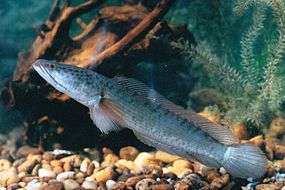Channa
| Channa | |
|---|---|
 | |
| Channa lucius | |
 | |
| Channa striata | |
| Scientific classification | |
| Kingdom: | Animalia |
| Phylum: | Chordata |
| Class: | Actinopterygii |
| Order: | Perciformes |
| Family: | Channidae |
| Genus: | Channa Scopoli, 1777 |
| Type species | |
| Channa orientalis Bloch & J. G. Schneider, 1801 | |
| Synonyms | |
|
Bostrychoides Lacépède, 1801 | |
Channa is a genus of fish in the family Channidae, commonly known as snakehead. This genus 34 contains scientifically described species, but the most well known are probably the Northern snakehead (Channa argus) and the Giant snakehead (Channa micropeltes). These species have a wide natural distribution extending from Iran in the west, to China in the east and parts of Siberia in the Far East. They are one of the most common staple food fish in Cambodia, Thailand, Vietnam and other South East Asian countries, where they are extensively cultured. Apart from their importance as a food fish, snakeheads are also consumed as a therapeutic for wound healing as well as reducing post-operative pain and discomfort and collected for the international aquarium pet trade. The diets of various species of Channa include fish, frogs, snakes, rodents, birds and insects. Some can move on land like snakes and breathe air.
The taxonomy of the genus Channa is incomplete and a comprehensive revision of the family has not been performed. A phylogenetic study in 2010 has also indicated the likelihood of the existence of more undescribed species of channids in South East Asia.[1] In June 2011, the Malabar snakehead Channa diplogramma from peninsular India was shown to be a distinct species, 146 years after its initial description and 134 years after it was synonymised with C. micropeltes, establishing it is an endemic species of peninsular India. The study also suggested that the species shared a most recent common ancestor with C. micropeltes, around 9.52 to 21.76 MYA.[2][3]
In Assamese it is called goroi. In Malayalam it is called varal or braal.
Species
There are currently 34 recognized species in this genus:
- Channa amphibeus (McClelland, 1845) (Borna snakehead)
- Channa andrao Britz, 2013 [4]
- Channa argus (Cantor, 1842) (Northern snakehead)
- Channa asiatica (Linnaeus, 1758) (Small snakehead)
- Channa aurantimaculata Musikasinthorn, 2000
- Channa aurantipectoralis Lalhlimpuia, Lalronunga & Lalramliana, 2016 [5]
- Channa bankanensis (Bleeker, 1853)
- Channa baramensis (Steindachner, 1901)
- Channa barca (F. Hamilton, 1822) (Barca snakehead)
- Channa bleheri Vierke, 1991 (Rainbow snakehead)
- Channa burmanica B. L. Chaudhuri, 1919
- Channa cyanospilos (Bleeker, 1853)
- Channa diplogramma (F. Day, 1865) (Malabar snakehead)
- Channa gachua (F. Hamilton, 1822) (Dwarf snakehead)
- Channa harcourtbutleri (Annandale, 1918) (Burmese snakehead)
- Channa lucius (G. Cuvier, 1831)
- Channa maculata (Lacépède, 1801) (Blotched snakehead)
- Channa marulioides (Bleeker, 1851)
- Channa marulius (F. Hamilton, 1822) (Great snakehead)
- Channa melanoptera (Bleeker, 1855)
- Channa melanostigma Geetakumari & Vishwanath, 2011 [6]
- Channa melasoma (Bleeker, 1851) (Black snakehead)
- Channa micropeltes (G. Cuvier, 1831) (Indonesian snakehead)
- Channa ninhbinhensis V. H. Nguyễn, 2011 [7]
- Channa nox C. G. Zhang, Musikasinthorn & Watanabe, 2002 (Night snakehead)
- Channa orientalis Bloch & J. G. Schneider, 1801 (Walking snakehead)
- Channa ornatipinnis Britz, 2008
- Channa panaw Musikasinthorn, 1998 (Panaw snakehead)
- Channa pardalis Knight, 2016 [8]
- Channa pleurophthalma (Bleeker, 1851)
- Channa pulchra Britz, 2007
- Channa punctata (Bloch, 1793) (Spotted snakehead)
- Channa stewartii (Playfair (fr), 1867) (Assamese snakehead)
- Channa striata (Bloch, 1793) (Striped snakehead)
References
- ↑ Adamson, E.A.S., Hurwood, D.A. & Mather, P.B. (2010): A reappraisal of the evolution of Asian snakehead fishes (Pisces, Channidae) using molecular data from multiple genes and fossil calibration. Molecular Phylogenetics and Evolution, 56 (2): 707–717.
- ↑ Benziger, A., Philip, S., Raghavan, R., Ali, P.H.A., Sukumaran, M., Tharian, J.C., Dahanukar, N., Baby, F., Peter, R., Rema Devi, K., Radhakrishnan, K.V., Haniffa, M.A., Britz, R. & Antunes, A. (2011): Unraveling a 146 Years Old Taxonomic Puzzle: Validation of Malabar Snakehead, Species-Status and Its Relevance for Channid Systematics and Evolution. PLoS ONE, 6 (6): e21272.
- ↑ Li, X., Musikasinthorn, P. & Kumazawa, Y. (2006): Molecular phylogenetic analyses of snakeheads (Perciformes: Channidae) using mitochondrial DNA sequences. Ichthyological Research, 53 (2): 148-159.
- ↑ Britz, R. (2013): Channa andrao, a new species of dwarf snakehead from West Bengal, India (Teleostei: Channidae). Zootaxa, 3731 (2): 287–294.
- ↑ Lalhlimpuia, D.v., Lalronunga, S. & Lalramliana (2016): Channa aurantipectoralis, a new species of snakehead from Mizoram, north-eastern India (Teleostei: Channidae). Zootaxa, 4147 (3): 343-350.
- ↑ Geetakumari, K. & Vishwanath, W. (2011): Channa melanostigma, a new species of freshwater snakehead from north-east India (Teleostei: Channidae). Journal of the Bombay Natural History Society, 107 (3): 231-235.
- ↑ Nguyen, V.H. (2011): Two new species belong to genus Channa (Channidae, Perciformes) discovered in Ninh Binh province, Vietnam. Vietnam Journal of Biology, 33 (4): 8-17.
- ↑ Knight, J.D.M. (2016): Channa pardalis, a new species of snakehead (Teleostei: Channidae) from Meghalaya, northeastern India. Journal of Threatened Taxa, 8 (3): 8583-8589.